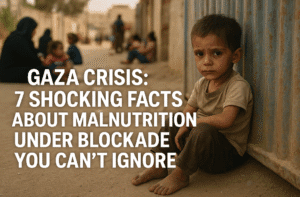Gaza Crisis: 7 Shocking Facts About Malnutrition Under Blockade You Can’t Ignore
Gaza’s children are enduring a devastating malnutrition crisis as Israel’s six-week blockade halts all food and aid, leaving families to survive on one meal a day. Over 3,600 children were treated for acute malnutrition in March alone, with aid groups warning of famine-like conditions as stocks of rice, pasta, and canned goods dwindle. Humanitarian operations are collapsing: 95% of aid organizations have reduced or halted work due to relentless Israeli bombardment, which has killed 60 aid workers since March and left clinics, shelters, and water systems in ruins.
Israel defends the blockade as pressure on Hamas to release hostages, but critics condemn it as collective punishment, with 400,000 newly displaced Palestinians joining 90% of Gaza’s population already uprooted. Hospitals report children dying from preventable illnesses exacerbated by hunger, while parents describe scouring rubble for scraps.
The UN warns Gaza’s food production is decimated, aid kitchens can only meet half the demand, and clean water is nearly nonexistent. With ceasefire talks stalled and Hamas rejecting Israel’s terms, the death toll surpasses 51,000—most women and children—as global calls for intervention go unanswered. The world watches a generation starve, trapped in a war where survival hinges on political will.

Gaza Crisis: 7 Shocking Facts About Malnutrition Under Blockade You Can’t Ignore
As the sun rises over Gaza’s battered landscape, thousands of children wake to another day of hunger. Aid organizations warn that Israel’s strict blockade, now in its seventh week, has pushed the territory into one of the most severe humanitarian crises in modern history. With food, medicine, and fuel barred from entry, families are surviving on a single meal a day, and malnutrition rates among children have surged to alarming levels.
The Human Toll of Deprivation
The United Nations reports that nearly all of Gaza’s 2.3 million residents rely on charity kitchens for survival. These kitchens, strained by dwindling supplies, can only provide one million daily meals—primarily rice or pasta devoid of essential nutrients. Markets, once a lifeline, now sell canned goods at exorbitant prices, while fresh produce and meat have vanished. For children, the consequences are dire: over 3,600 were treated for acute malnutrition in March alone, a 70% spike from February. Medical facilities, themselves targets of bombardment, struggle to operate, leaving many without care.
“Children are eating less than a meal a day,” said Bushra Khalil of Oxfam. “Malnutrition isn’t looming—it’s here, and it’s killing Gaza’s future.”
Aid Collapses Amid Relentless Conflict
The humanitarian infrastructure is crumbling. Twelve major aid groups, including Save the Children and Doctors Without Borders, report that 95% of operations have halted due to Israeli airstrikes and ground incursions. Since March, at least 60 aid workers have been killed, and facilities like the International Committee of the Red Cross have been struck multiple times. With Israel halting coordination efforts, aid convoys navigate active combat zones without safety assurances.
“We’re forced to watch people suffer while facing the same threats ourselves,” said Amande Bazerolle of Doctors Without Borders.
Political Stalemate Deepens Suffering
Israel defends the blockade as a tactic to pressure Hamas into releasing hostages and disarming. Defense Minister Israel Katz insists on maintaining “security zones” in Gaza post-conflict, while Hamas demands a full Israeli withdrawal and prisoner releases before negotiating further hostage exchanges. Meanwhile, civilians bear the brunt: over 51,000 Palestinians, mostly women and children, have been killed since the war began in October 2023, and 400,000 have fled their homes in recent weeks.
A Generation at Risk
Beyond immediate hunger, the blockade’s long-term effects are catastrophic. Water scarcity forces families to ration as little as six liters per person daily—far below the UN’s survival minimum. Schools-turned-shelters lie in ruins, and Gaza’s agricultural and economic systems are decimated. Aid workers warn that without urgent intervention, an entire generation faces stunted growth, cognitive impairments, and trauma.
The Path Forward
International bodies have decried the crisis as a “political choice” violating humanitarian law. Yet diplomatic efforts remain gridlocked. As global attention wavers, Gaza’s families cling to survival, their resilience tested by each passing day.
In Summary: Gaza’s blockade has transcended warfare, morphing into a battle against starvation and systemic collapse. Without immediate aid access and a ceasefire, the toll on children and civilians will escalate from tragedy to irreversible catastrophe. The world’s response—or lack thereof—will define this chapter in Gaza’s decades-long struggle for survival.
You must be logged in to post a comment.